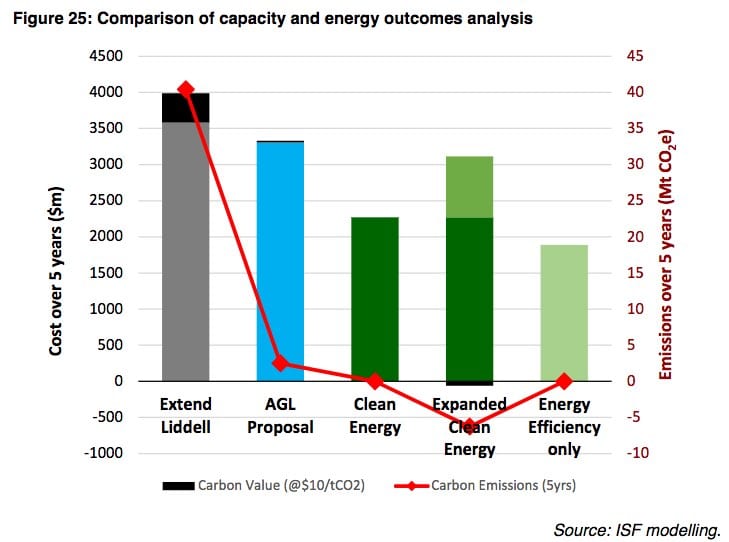The Turnbull government’s plan to keep the New South Wales Liddell coal-fired power plant open beyond its use by date would cost upwards of $1.3 billion more than replacing it with a mix of renewables and energy management systems, a new report has found.
The research, conducted by the Institute of Sustainable Futures and commissioned by the Australian Conservation Foundation, is just the latest to illustrate the economic folly of keeping Australia’s oldest coal plant in the national electricity mix, in an age when renewable energy costs and carbon budgets are dwindling.
The report finds that a combination of wind power, demand management and energy efficiency would cost $2.2 billion over five years, compared to a cost of $3.6 billion to keep Liddell open for five years beyond its retirement age.
The AGL Energy owned Liddell – which AGL itself has repeatedly described as unreliable and costly – is slated for closure in 2022, at which time it will have reached the grand old age of 50.
But in its efforts to reassure voters on national energy security, the federal Coalition has proposed keeping the plant open for another five years beyond that date.
This has been dismissed as an expensive and outdated solution by a number of analysts and industry players, not least of all AGL, which has its own plan to replace the shuttered plant’s capacity, with a mix of existing coal, new high efficiency gas power, new renewables, and batteries and demand response.
AGL has estimated it would cost the company around $900 million to keep Liddell open another 10 years, as requested by the federal Coalition – the company has already spent $140 million in the last three years and plans another $160 million to keep it open until 2022.
And in October, a report by Reputex said investing to extend the life of the ageing Liddell coal plant would likely result in higher costs than a new large scale solar project with battery storage.
But the ISF modelling – released on Monday – suggests it would cost much more than $900 million to keep Liddell open to 2027, making it more expensive even than replacing it with an “expanded clean energy package” combining wind, solar thermal, bioenergy, batteries, smart controls and efficiency, at an estimated cost of $3.1 billion.
Furthermore, the basic clean energy package – which would also be cheaper than AGL’s proposed plan – would have zero carbon emissions compared to 40 million tonnes of carbon dioxide over five years in the case of the Extend Liddell proposal and 2.5 million tonnes of carbon dioxide for the AGL’s scenario, the report found.
ISF research director, Chris Dunstan, said using clean energy solutions to address the closure of Liddell would not only be much cheaper, but would set an important precedent for the rest of the nation’s ageing coal-fired power fleet.
“As much as 60 per cent of Australia’s coal fired power stations are expected to reach retirement age in the next 15 years,” Dunstan said in comments on Monday.
“Now is the time to prepare for this transition. The good news is that by replacing this capacity with smarter, clean energy options we can reduce costs, reduce emissions, create jobs and maintain reliable electricity supply.”
For ACF CEO Kelly O’Shanassy, the results spoke strongly about the divide between Australia’s top politicians and the current state of the energy market transition.
“Australia desperately needs a comprehensive climate change policy that will facilitate the rapid transition to a clean energy future.” she said.
“Any climate change and energy policy, be it the National Energy Guarantee or another proposal, must be designed to encourage as much clean energy and smart technology as possible, and not prop-up polluting coal plants that are damaging our planet.”











